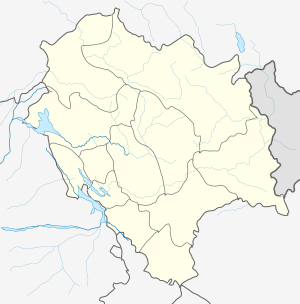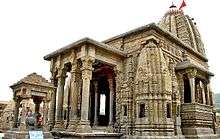Baijnath, Himachal Pradesh
Baijnath is a town in Kangra district of Himachal Pradesh. It is about 50 kilometres from Dharamshala which is the district headquarters. The ancient temple of Lord Shiva (Baijnath) is situated here giving the town its name .
Baijnath | |
|---|---|
town | |
 Baijnath Location in Himachal Pradesh, India  Baijnath Baijnath (India) | |
| Coordinates: 32.05°N 76.65°E | |
| Country | |
| State | Himachal Pradesh |
| District | Kangra |
| Elevation | 998 m (3,274 ft) |
| Languages | |
| • Official | Hindi |
| Time zone | UTC+5:30 (IST) |
| PIN | 176125 |
Geography
Baijnath is located at 32.05°N 76.65°E.[1] It has an average elevation of 998 metres (3274 feet). It is a small township in the Dhauladhar range of western Himalayas, 16 km from Palampur in the Kangra District of Himachal Pradesh. It is also related with Ravana.
Baijnath Temple

The main attraction of Baijnath is an ancient, Baijnath Temple, a temple of Lord Shiva. Neighbouring towns are Palampur,Paprola, Kangra and Joginder Nagar in Mandi district. According to the legend, it is believed that during the Treta Yuga, Ravana in order to have invincible powers worshiped Lord Shiva in the Kailash. In the same process, to please the almighty he offered his ten heads in the havan kund. Influenced by this extra ordinary deed of the Ravana, the Lord Shiva not only restored his heads but also bestowed him with powers of invincibility and immortality.
On attaining this incomparable boon, Ravana also requested Lord Shiva to accompany him to Lanka. Shiva consented to the request of Ravana and converted himself into Shivling. Then Lord Shiva asked him to carry the Shivling and warned him that he should not place the Shivling down on the ground on his way as Shiva said wherever you will keep me, in this Linga form, I will rest there only, the Linga will be stay there only. Ravana started moving south towards Lanka and reached Baijnath. He was thirsty and saw Lord Ganesha, disguised as a shepherd and asked for water. Lord Ganesh had requested Lord of Water/Lord of Sea (Varuna) to fill the entire in the small pot of water which he offered to Ravan. On drinking it, Ravana, felt the urge to answer nature's call and handed over the Shivling to Ganesh and went away to get himself relieved. Lord Ganesh put the linga on the ground and thus the Shivling got established there and the same is in the form of Ardhnarishwar (God in form of Half Male & Half Female).
In the town of Baijnath, Dussehra festival in which traditionally the effigy of the Ravana is consigned to flames, celebrated all over the country is not celebrated as a mark of respect to the devotion of Ravana towards Lord Shiva. Another interesting thing about the town of Baijnath is that there are no shops of goldsmiths here .
Another version also suggests that while Ravana was descending from the Himalayas with the Shivling Lord Shiva had awarded him after years of worship which was supposed to be established at Lanka, now Sri Lanka, which would have blessed him (Ravana) with undefeatable powers even to the Gods which was not to be placed anywhere during the course of travel, even during resting, Ravana was tricked by one of the Devas (Gods), who posed as a beggar and wanted help from Ravana and promised to hold the Shivling for him while he (Ravana) could fetch some food for the beggar. The Deva posing as beggar placed the Shivling on ground, in absence of Ravana. The Shiva idol or the Shivling at Baijnath temple is the same Shivling which was placed by the Deva after tricking Ravana.
The history of the ancient Baijnath Temple is hazy and the two long inscriptions fixed in the walls of the mandapa of the temple gives us account of the temple. The temple was built in Saka 1126 (CE 1204)by two brothers Manyuka and Ahuka in devotion to Lord Vaidyanatha. The inscriptions tell us that a Sivalinga known as Vaidyanatha already existed on the spot but was without a proper house so the present temple and a porch in its front was constructed. British Archaeologist Alexander Cunningham noticed an inscription of 1786 in the temple referring to its renovations by king Sansara Chandra. An inscription on the wooden doors of the sanctum of the temple provides the date as samvat 1840 (AD 1783) that is very near to Cunningham's date. The devastating earthquake that shook the entire region of Kangra on 4 April 1905 also caused damage to the shrine, which has been reported by J. Ph. Vogel and has since been repaired. At present the temple is a protected monument under the Archaeological Survey of India but the performance of worship and rituals are under a local board at Baijnath with SDM as its chairman. The hereditary priests continue to get a share of the offerings.[2]
Tourism
Baijnath is around 51 kilometres from Kangra. Besides the main temple there are several other shrines which are of equal importance for the local residents. Some of them are Mukut Nath temple at Sansal (6 km) and Awahi Nag temple (1.5 km) the Mahankal Temple (5 km) at Mahankal on Chobin Road, Shobha Singh Art gallery (Andretta/Panchrukhi 11 km from Baijnath). The town offers splendid views of the Dhauladhar Ranges and numurous mountain streams. Tibetan Monasteries at Sherabling (Bhattu) (5 km), Chauntra and Chowgan on the Mandi Highway and at Bir (14 km).Billing (28 km) is an international paragliding site which is considered as one of the best in the world for paragliding and other aerosports. The site has been the host to international events such as the Paragliding Pre-World Cup multiple times and other national and international events.
 Panoramic view of Shiva Temple of Baijnath
Panoramic view of Shiva Temple of Baijnath Panoramic view of Shiva Temple of Baijnath
Panoramic view of Shiva Temple of Baijnath

_at_entrance_of_Shiva_Temple_of_Baijnath_%2CHimachal_Pradesh_%2CIndia_09.jpg) Sacrad bell (Tall)
Sacrad bell (Tall)
 Inner view
Inner view Outer view of Architect of Shiva temple
Outer view of Architect of Shiva temple
External links
| Wikivoyage has a travel guide for Baijnath. |
| Wikimedia Commons has media related to Baijnath, Himachal Pradesh. |